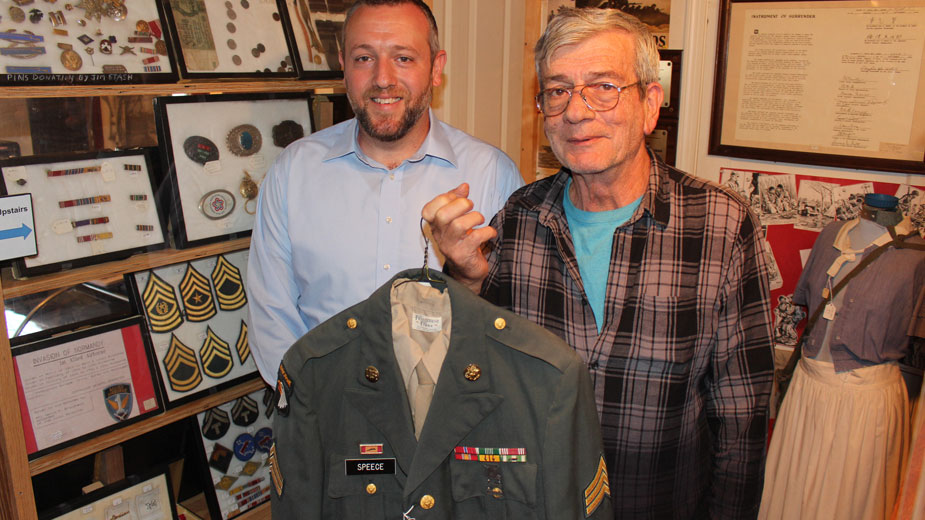Their Stories Survive at War Vet Museum
CANFIELD, Ohio — On Feb. 1, 1945, Staff Sgt. George W. Hanger was killed while fighting in the Pacific during World War II.
It’s believed the Ohio native, a member of the 25th Bomber Squadron from the 40th Bomber Group, was shot down in action, although no one knows for sure because his body was never recovered.
What also remains unknown is how his military issued hat, decades later, came into the possession of John Dekhane, a collector living in France who noticed the hat among his items.
“Maybe his footlocker got sold off?” speculates Doug Speece Jr., who runs the War Vet Museum in Canfield.
Luckily, Hanger had his name inscribed on the inside of the hat. Dekhane researched the owner and discovered he was from Ohio.

“He found us and wanted it to come back to Ohio so he shipped it to me,” Speece says.
Today, Hanger’s hat is one of nearly 45,000 items that have found a home at the museum, opened in 1988 by Speece’s grandfather, Lewis Speece.
The grandson says the hat is a prime example of why the World War II veteran opened the museum.
“Sometimes people didn’t know what to do with their family’s stuff or they would move into a house and find stuff,” Speece says. “My grandfather wanted a place where you could bring these kinds of items and display them to honor the veterans.”

Items in the museum include weapons, uniforms, newspapers and photos, although just about anything can be found. All the items are donated, says Doug Speece Sr., who took over the museum after his father died in 2015. Today, he runs it with the help of his wife, Pam, his son, Doug Jr., and a few volunteers.
“If somebody brings something here, it’s got a home forever,” he explains. “We don’t buy or sell anything. That’s why people bring it here. They don’t want it to be sold.”
Each room in the Vet Museum is dedicated to a different piece of American military history, and each item has a story. In the World War II room is a German pistol an American soldier acquired from a captured German officer. Perhaps under duress, the German officer traded the weapon for a pack of cigarettes.
The basement level houses several train sets and model landscapes depicting famous battles, such as the battle of Gettysburg. Veterans painstakingly crafted many of the models. “It’s amazing some of the detail they put into these,” Speece Jr. says.

The museum, 23 East Main St., is itself a piece of military history. It was built in 1809 by Comfort Starr Mygatt, a veteran of the Revolutionary War and the War of 1812. The house was later owned by John R. Church, a lieutenant in the War of 1812, and then by James Madison Nash, a colonel in the Civil War.
Today, the museum houses items from the Revolutionary War to the conflicts in Iraq and Afghanistan. One of the most recent items to be donated is a uniform from World War II.
“We’re pretty sure that the owner was in the D-Day invasion,” Speece Jr. says, as he examines the medals adorning it.
One of the first things people notice when they examine the uniforms is their size. “It amazes me how small these guys were back then,” he says.
All of the items inside the museum are carefully catalogued by a number system Lewis Speece set up. It can be a bit “tedious when you want to relocate something, because you have to go in and change all the records,” the grandson says.
Still, it works well.
“A lady came in looking for her father’s Korean War uniform,” which she had never seen, he recounts. “She got to see it and became emotional and teared up.”
Some of Speece Jr.’s favorite items include photos, which he keeps in binders in a backroom. “Sometimes they have documents in there so it gives a little story. I like that,” he says, as he looks through one.
“It’s amazing that some of this stuff survived,” Speece Sr. says. “I mean, how did it get back here after all these years?”
The museum regularly hosts tours for school children and scout troops. It’s open to the public on Saturdays, and is busiest on Memorial Day and the Fourth of July.
Near the front of the museum, visitors will find several items from Lewis Speece’s days in the military, although the most enduring piece of his legacy remains the museum itself. And his descendants aim to make sure his memory, along with all those whose effects can be found inside, lasts forever.
“That’s why we put in all the time,” says Speece Jr.. “It’s been here for 30 years and we want to make sure it stays here.”
Pictured above: Doug Speece Jr. and Doug Speece Sr. are the volunteer operators of the museum.
Copyright 2024 The Business Journal, Youngstown, Ohio.



